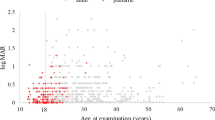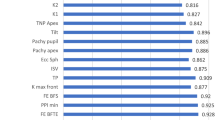Abstract
Purpose
The aim of this study was to determine the age- and sex-specific incidence and prevalence of keratoconus (KC) in Taiwan and explore their association with the use of computerized corneal topography and tomography (TG).
Design
This nationwide retrospective study included the Taiwanese population (N = 27,540,859) from the National Health Insurance Research Database (NHIRD) between 2000 and 2018.
Method
We estimated the incidence of KC by identifying patients with newly diagnosed KC and estimated its prevalence by identifying patients who had the ICD9-CM code 371.6 or ICD-10-CM code H18.609 twice or more in NHIRD during 2000–2018.
Results
The incidence of KC in Taiwan during 2000–2018 was 7075, with the incidence rate being 1.56 (95% confidence interval [CI]: 1.53–1.60) per 100,000 person-years. The prevalence of KC was 4.29 (95% CI: 4.23–4.35) per 100,000 person-years. The KC incidence rate peaked in patients aged 21–25 (6.40 in males and 3.19 in females). The overall incidence rates in males and females were 2.01 and 1.35, respectively (incidence rate ratio: 1.46), indicating that KC had a significant male predisposition. Moreover, we noted a linear correlation (R2 = 0.7488) between the proportion of the use of TG and the incidence of KC.
Conclusion
Estimates of nationwide population-based incidence and prevalence can contribute to a better understanding of the risk of ethnic groups and geographic locations in KC, and the trend can help physicians improve the general vision health of the population.
This is a preview of subscription content, access via your institution
Access options
Subscribe to this journal
Receive 18 print issues and online access
$259.00 per year
only $14.39 per issue
Buy this article
- Purchase on Springer Link
- Instant access to full article PDF
Prices may be subject to local taxes which are calculated during checkout





Similar content being viewed by others
Data availability
Our data availability is legally restricted. The data we used in this study were owned by a third-party organization, the Health and Welfare Data Science Center (HWDC), an official data center belonging to the Ministry of Health and Welfare. According to government regulation, the data were only available upon request by researchers, not open to the general public. Fellow researchers can apply for the use of the whole database with an ethical permit issued by the institutional review board. The Application Management Review Committee in HWDC will issue access to the national database.
References
Galvis V, Sherwin T, Tello A, Merayo J, Barrera R, Acera A. Keratoconus: an inflammatory disorder? Eye (Lond). 2015;29:843–59. https://doi.org/10.1038/eye.2015.63.
Gordon-Shaag A, Millodot M, Shneor E, Liu Y. The genetic and environmental factors for keratoconus. Biomed Res Int. 2015;2015:795738. https://doi.org/10.1155/2015/795738.
Romero-Jiménez M, Santodomingo-Rubido J, Wolffsohn JS. Keratoconus: a review. Cont Lens Anterior Eye. 2010;33:157–205. https://doi.org/10.1016/j.clae.2010.04.006.
Santodomingo-Rubido J, Carracedo G, Suzaki A, Villa-Collar C, Vincent SJ, Wolffsohn JS. Keratoconus: an updated review. Cont Lens Anterior Eye. 2022;45:101559. https://doi.org/10.1016/j.clae.2021.101559.
Hashemi H, Heydarian S, Hooshmand E, Saatchi M, Yekta A, Aghamirsalim M, et al. The prevalence and risk factors for keratoconus: a systematic review and meta-analysis. Cornea. 2020;39:263–70. https://doi.org/10.1097/ICO.0000000000002150.
Castro-Luna G, Pérez-Rueda A. A predictive model for early diagnosis of keratoconus. BMC Ophthalmol. 2020;20:1–9. https://doi.org/10.1186/s12886-02001531-9.
Ambrósio R Jr., Belin MW. Imaging of the cornea: topography vs tomography. J Refract Surg. 2010;26:847–9. https://doi.org/10.3928/1081597X-20101006-01.
Gokhale NS. Epidemiology of keratoconus. Indian J Ophthalmol. 2013;61:382–3. https://doi.org/10.4103/0301-4738.116054.
Georgiou T, Funnell CL, Cassels-Brown A, O’Conor R. Influence of ethnic origin on the incidence of keratoconus and associated atopic disease in Asians and white patients. Eye (Lond). 2004;18:379–83. https://doi.org/10.1038/sj.eye.6700652.
Woodward MA, Blachley TS, Stein JD. The association between sociodemographic factors, common systemic diseases, and keratoconus: an analysis of a nationwide heath care claims database. Ophthalmology. 2016;123:457–65.e2. https://doi.org/10.1016/j.ophtha.2015.10.035.
Godefrooij DA, de Wit GA, Uiterwaal CS, Imhof SM, Wisse RP. Age-specific incidence and prevalence of keratoconus: a nationwide registration study. Am J Ophthalmol. 2017;175:169–72. https://doi.org/10.1016/j.ajo.2016.12.015.
Hwang S, Lim DH, Chung TY. Prevalence and Incidence of Keratoconus in South Korea: a nationwide population-based study. Am J Ophthalmol. 2018;192:56–64. https://doi.org/10.1016/j.ajo.2018.04.027.
Gomes JA, Tan D, Rapuano CJ, Belin MW, Ambrósio R, Jr., Guell JL, et al. Global consensus on keratoconus and ectatic diseases. Cornea. 2015;34:359–69. https://doi.org/10.1097/ICO.0000000000000408.
National Health Insurance Administration, Ministry of Health and Welfare, Taiwan. The 2018 National Health Insurance statistics. 2022. https://www.nhi.gov.tw/english/Content_List.aspx?n=7633F778C11A6CF3&topn=BCB2B0D2433F6491.
National Cancer Institute, USA. Survillance, Epidemiology, and End Results (SEER): World (WHO 2000-2025) Standard. 2022. https://seer.cancer.gov/stdpopulations/world.who.html.
Spronk I, Korevaar JC, Poos R, Davids R, Hilderink H, Schellevis FG, et al. Calculating incidence rates and prevalence proportions: not as simple as it seems. BMC Public Health. 2019;19:512. https://doi.org/10.1186/s12889-019-6820-3.
Pearson AR, Soneji B, Sarvananthan N, Sandford-Smith JH. Does ethnic origin influence the incidence or severity of keratoconus? Eye (Lond). 2000;14:625–8. https://doi.org/10.1038/eye.2000.154.
Gorskova EN, Sevost’ianov EN. [Epidemiology of keratoconus in the Urals]. Vestn Oftalmol. 1998;114:38–40.
Al-Amri A. Prevalence of keratoconus in a refractive surgery population. J Ophthalmol. 2018;2018:5983530. https://doi.org/10.1155/2018/5983530.
Papaliʼi-Curtin AT, Cox R, Ma T, Woods L, Covello A, Hall RC. Keratoconus prevalence among high school students in New Zealand. Cornea. 2019;38:1382–9. https://doi.org/10.1097/ICO.0000000000002054.
Hashemi H, Khabazkhoob M, Yazdani N, Ostadimoghaddam H, Norouzirad R, Amanzadeh K, et al. The prevalence of keratoconus in a young population in Mashhad, Iran. Ophthalmic Physiol Opt. 2014;34:519–27. https://doi.org/10.1111/opo.12147.
Ferrari G, Rama P. The keratoconus enigma: a review with emphasis on pathogenesis. Ocul Surf. 2020;18:363–73. https://doi.org/10.1016/j.jtos.2020.03.006.
Flockerzi E, Xanthopoulou K, Goebels SC, Zemova E, Razafimino S, Hamon L, et al. Keratoconus staging by decades: a baseline ABCD classification of 1000 patients in the Homburg Keratoconus Center. Br J Ophthalmol. 2021;105:1069–75. https://doi.org/10.1136/bjophthalmol-2020316789.
Klein R, Klein BE. The prevalence of age-related eye diseases and visual impairment in aging: current estimates. Invest Ophthalmol Vis Sci. 2013;54:ORSF5–13. https://doi.org/10.1167/iovs.13-12789.
Ertan A, Muftuoglu O. Keratoconus clinical findings according to different age and gender groups. Cornea. 2008;27:1109–13. https://doi.org/10.1097/ICO.0b013e31817f815a.
Weed KH, MacEwen CJ, Giles T, Low J, McGhee CN. The Dundee University Scottish Keratoconus study: demographics, corneal signs, associated diseases, and eye rubbing. Eye (Lond). 2008;22:534–41. https://doi.org/10.1038/sj.eye.6702692.
Jonas JB, Nangia V, Matin A, Kulkarni M, Bhojwani K. Prevalence and associations of keratoconus in rural Maharashtra in central India: the central India eye and medical study. Am J Ophthalmol. 2009;148:760–5. https://doi.org/10.1016/j.ajo.2009.06.024.
McKay TB, Hjortdal J, Sejersen H, Karamichos D. Differential effects of hormones on cellular metabolism in keratoconus in vitro. Sci Rep. 2017;7:42896. https://doi.org/10.1038/srep42896.
Bilgihan K, Hondur A, Sul S, Ozturk S. Pregnancy-induced progression of keratoconus. Cornea. 2011;30:991–4. https://doi.org/10.1097/ICO.0b013e3182068adc.
Pan CW, Cheng CY, Sabanayagam C, Chew M, Lam J, Ang M, et al. Ethnic variation in central corneal refractive power and steep cornea in Asians. Ophthalmic Epidemiol. 2014;21:99105. https://doi.org/10.3109/09286586.2014.887735.
Bantz SK, Zhu Z, Zheng T. The Atopic March: progression from atopic dermatitis to allergic rhinitis and asthma. J Clin Cell Immunol. 2014;5:202. https://doi.org/10.4172/2155-9899.1000202.
Hwang CY, Chen YJ, Lin MW, Chen TJ, Chu SY, Chen CC, et al. Prevalence of atopic dermatitis, allergic rhinitis and asthma in Taiwan: a national study 2000 to 2007. Acta Derm Venereol. 2010;90:589–94. https://doi.org/10.2340/00015555-0963.
Hsieh CY, Su CC, Shao SC, Sung SF, Lin SJ, Kao Yang YH, et al. Taiwan’s National Health Insurance Research Database: past and future. Clin Epidemiol. 2019;11:349–58. https://doi.org/10.2147/clep.S196293.
Matalia H, Swarup R. Imaging modalities in keratoconus. Indian J Ophthalmol. 2013;61:394–400. https://doi.org/10.4103/0301-4738.116058.
Cavas-Martínez F, De la Cruz Sánchez E, Nieto Martínez J, Fernández Cañavate FJ, Fernández-Pacheco DG. Corneal topography in keratoconus: state of the art. Eye Vis (Lond). 2016;3:5. https://doi.org/10.1186/s40662-016-0036-8.
Author information
Authors and Affiliations
Contributions
L-CS, CHH and JMN designed the study. L-CS and W-MC performed statistical analyses. CHH, K-KL and J-SL interpreted the findings. JMN, CHH and L-CS, and all co-authors, wrote the manuscript. All authors edited and approved the manuscript.
Corresponding author
Ethics declarations
Competing interests
The authors declare no competing interests.
Additional information
Publisher’s note Springer Nature remains neutral with regard to jurisdictional claims in published maps and institutional affiliations.
Rights and permissions
Springer Nature or its licensor (e.g. a society or other partner) holds exclusive rights to this article under a publishing agreement with the author(s) or other rightsholder(s); author self-archiving of the accepted manuscript version of this article is solely governed by the terms of such publishing agreement and applicable law.
About this article
Cite this article
Ng, J.M., Lin, KK., Lee, JS. et al. Incidence and prevalence of keratoconus in Taiwan during 2000–2018 and their association with the use of corneal topography and tomography. Eye 38, 745–751 (2024). https://doi.org/10.1038/s41433-023-02767-7
Received:
Revised:
Accepted:
Published:
Issue Date:
DOI: https://doi.org/10.1038/s41433-023-02767-7



